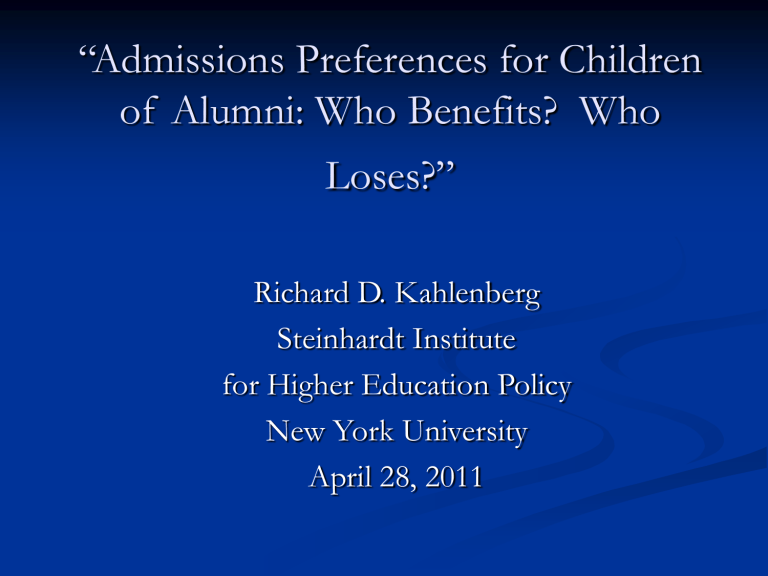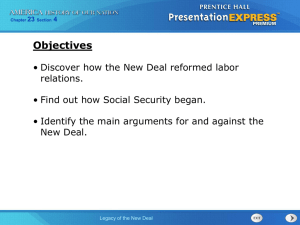NYU_Legacy_Event_4.28.11 - NYU Steinhardt

“Admissions Preferences for Children of Alumni: Who Benefits? Who
Loses?”
Richard D. Kahlenberg
Steinhardt Institute for Higher Education Policy
New York University
April 28, 2011
Q 1: Does it Matter Who Goes to
Selective Colleges and Universities?
A.
B.
C.
D.
Higher Spending
Higher Graduation Rates
Higher Earnings
Greater Chance at Leadership
Spending by Selectivity
$100,000
$80,000
$60,000
$40,000
$20,000
$-
Per-student Spending at Colleges, by Selectivity, 2006
$92,000
$12,000
Least-selective Colleges Most Selective Colleges
Note: Selectivity is measured by ranking all colleges according to the national percentile that corresponds with each college’s mean SAT or ACT score. Spending is reported in 2007 dollars.
Source: Caroline M. Hoxby, The Changing Selectivity of American Colleges, NBER Working Paper 15446 (Cambridge, MA:
National Bureau of Economic Research, 2009), 15.
50%
40%
30%
20%
10%
0%
100%
90%
80%
70%
60%
Higher Graduation Rates
Graduation Rates, by Selectivity and SAT-Equivalent Score
86%
83%
Tier 1 (highest selectivity) Tier 2 Tier 3 Tier 4 (lowest selectivity)
96%
85% 85%
78% 78%
71%
67%
70%
68%
96%
90%
78%
1000 to 1100
Data
0%
1100-1200 1200-1300
SAT-Equivalent Score
>1300
Data
0%
Note: SAT-equivalent scores are based on SAT scores or equivalent percentile correspondences of ACT scores to SAT equivalence. The correspondence was developed by ETS.
Source: Anthony P. Carnevale and Jeff Strohl, “How Increasing College Access Is Increasing Inequality, and What to Do about It,” in Rewarding Strivers: Helping Low-Income Students Succeed in College, Richard D. Kahlenberg, ed., (New York:
Century Foundation Press, 2010), 151, Table 3.5. Authors’ analysis of survey data from High School and Beyond, U.S.
Department of Education, National Center for Education Statistics, http://nces.ed.gov/surveys/hsb/ .
Higher Earnings
Entry-level Earnings of College Graduates, by Selectivity, 1999
$60,000
$50,000
$53,817
$41,779
$39,880
$40,000
$30,000
$20,000
$33,177
$37,081
$10,000
$-
Community college Less and noncompetitive college
Competitive college Very competitive college
Most and highly competitive college
Note: Dollar amounts are in 2007 dollars.
Source: Anthony P. Carnevale and Jeff Strohl, “How Increasing College Access Is Increasing Inequality, and What to Do about It,” in Rewarding Strivers: Helping Low-Income Students Succeed in College, Richard D. Kahlenberg, ed., (New York: Century Foundation
Press, 2010), 149, Figure 3.17. Authors’ calculations from Barron’s Selectivity Rankings, various years; National Education
Longitudinal Study: Base Year through Fourth Follow-Up, 1988-2000 (Washington, D.C.: U.S. Dept. of Education, National
Center for Education Statistics, 2000).
Leadership
Current Students or Graduates of 12 Elite Institutions as a
Percentage of Various Populations
60%
50%
40%
30%
42%
20%
10%
0%
0.7%
Current Undergraduate
College Students
Government Leaders
54%
Corporate Leaders
Current Students or
Graduates of Harvard, Yale, the University of Chicago,
Stanford, Columbia, MIT,
Cornell, Northwestern,
Princeton, Johns Hopkins, the University of
Pennsylvania, and Dartmouth
Note: Undergraduate population data for the 12 schools came from each institution’s website. All population counts are for 2009-
2010, except for those from Yale, Cornell, and Northwestern, which are for 2008-2009.
Source: Thomas Dye, Who’s Running America? (Upper Saddle River, NJ: Prentice Hall, 2002), 148. Current Population Survey
(Washington, D.C.: U.S. Census Bureau and U.S. Bureau of Labor Statistics, 2008), available at http://www.census.gov/population/www/socdemo/school/cps2008.html
, retrieved August 24, 2010.
Q 2: How much difference do legacy preferences make?
Used in almost ¾ of selective universities and almost all selective colleges.
Increase chances of admissions substantially.
Increased Chances of Admissions for Legacies in Three Studies
160 SAT points
1200
1360
Legacy
Bonus
19.7 percentage point increase
Child of Undergraduate
Alumnus:
45.1 percentage point increase
85.1 %
59.7 %
Legacy
Bonus
Legacy
Bonus
40 % 40 %
Source: Thomas J. Espenshade,
Chang Y. Chung, and Joan L.
Walling, “Admission Preferences for Minority Students, Athletes, and Legacies at Elite Universities,”
Social Science Quarterly 85, no. 5
(December 2004): 1431.
Source: William G. Bowen,
Martin A. Kurzweil and
Eugene M. Tobin, Equity and
Excellence in American Higher
Education (Charlottesville, Va.:
University of Virginia Press,
2005), 105-06.
Source: Michael Hurwitz, “The Impact of Legacy Status on
Undergraduate Admissions at Elite Colleges and
Universities,” Economics of Education Review 30, Issue 3 (June
2011): pp.480-492, and Elyse Ashburn, “At Elite Colleges,
Legacy Status May Count More Than Was Previously
Thought,” The Chronicle of Higher Education, January 5,
2011, http://chronicle.com/article/Legacys-Advantage-May-
Be/125812/
Q 3: What are the Historical Origins of Legacy Preferences?
Peter Schmidt’s chapter outlines the rise of legacy preferences after WWI as one way to limit admissions of immigrant students, particularly Jews.
Q 4: Are legacy preferences consistent with the ideals of a
Democratic Republic?
Michael Lind’s chapter on American experiment in Jeffersonian natural aristocracy vs. Old
World’s artificial inherited aristocracy.
Carlton Larson’s chapter on U.S. Constitution’s prohibition on granting titles of nobility.
Concludes legacy preferences are likely to have been viewed by founders as profoundly un-
American.
Q 5: Do legacy preferences increase alumni giving?
Surprisingly little research to date.
Chad Coffman’s chapter examines top 100 national universities as identified by U.S. News 1998-2008.
Those with alumni preferences had higher annual giving ($317 vs. 201) but once control for wealth of alumni, the difference was reduced to $15.39, and was statistically insignificant.
Concludes that with appropriate controls, “ there is no statistically significant evidence of a causal relationship between legacy-preference policies and total alumni giving at top universities.”
Q5: Alumni giving (cont.)
7 institutions dropped legacy preferences during the period of the study and there was “no shortterm measurable reduction in alumni giving as a result of abolishing legacy preferences.”
Of top 10 universities in the world in 2008 according to Shanghai University rankings, four
(Caltech, UC Berkeley, Oxford and Cambridge) do not employ legacy preference.
Q 6: What is the effect of legacy preference on students of color?
After a generation of affirmative action, is now the wrong time to pull out the rug on legacy preference just as students of color will benefit?
Chapter by John Brittain and Eric Bloom finds under-represented minorities hurt, not helped, by legacy preferences.
Under-represented Minority Proportions of National
Applicant Pool at 18 National Universities, Legacy Pool, and
U.S. Population (2005)
35
30
25
33
20
15
10
12.5
6.7
5
0
Entire Applicant
Pool
Legacy Applicant
Pool
U.S. Population
Source: William G. Bowen, Martin A. Kurzweil, and Eugene M. Tobin, Equity and Excellence in American Higher Education
(Charlottesville, VA: Univ. of Virginia Press, 2005), 168 (under-represented minority proportion of entire and legacy applicant pools); applicant pool data from all 18 national schools for which authors had legacy data. U.S. Census Bureau, Population
Division, Population Estimates Program, Vintage 2005, July 1, 2005 (minority proportion of U.S. population).
Texas A&M Legacy Admits in 2002 Who Otherwise
Would Not Have Been Admitted
350
300
250
200
150
100
50
0
321
3
25
White Black Hispanic
Source: Todd Ackerman, “Legislators Slam A&M over Legacy Admissions,” Houston Chronicle, Jan 4, 2004, A1.
Expected vs. Actual Black and Hispanic Enrollment at
Top 50 Elite Colleges in 2008
35
30
25
20
15
10
5
0
Expected
Proportion
Actual proportion
Black &
Hispanic
Black Hispanic
Expected proportion is based on the demographic group’s proportion of the traditional college-aged population. The “Top 50
Colleges” refer to the 50 national universities ranked highest by U.S. News & World Report.
Source: U.S. Department of Education, National Center for Education Statistics, IPEDS Peer Analysis System, 2008 Four-year,
Not-for-profit and Public, Degree-Granting, Title-IV Participating Institutions; U.S. News & World Report: Best Colleges 2008;
U.S. Department of Education, National Center for Education Statistics Digest of Education Statistics (2008), Table 227.
Q 7: Are legacy preferences legal?
Chapter by Steve Shadowen and Sozi Tulante
Public institutions – may violate 14 th amendment’s “equal protection clause” which is meant to outlaw discrimination based on lineage, of which race is a subset.
Private institutions – may violate 1866 Civil
Rights Act which prohibits “ancestry” discrimination.
May be litigation in the near future.







